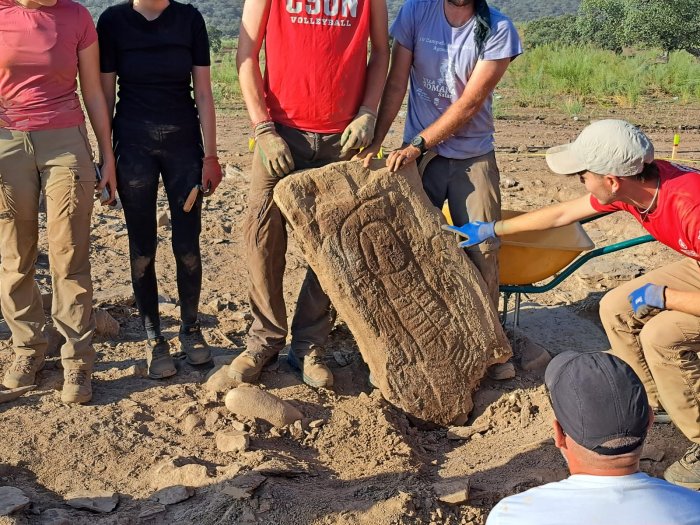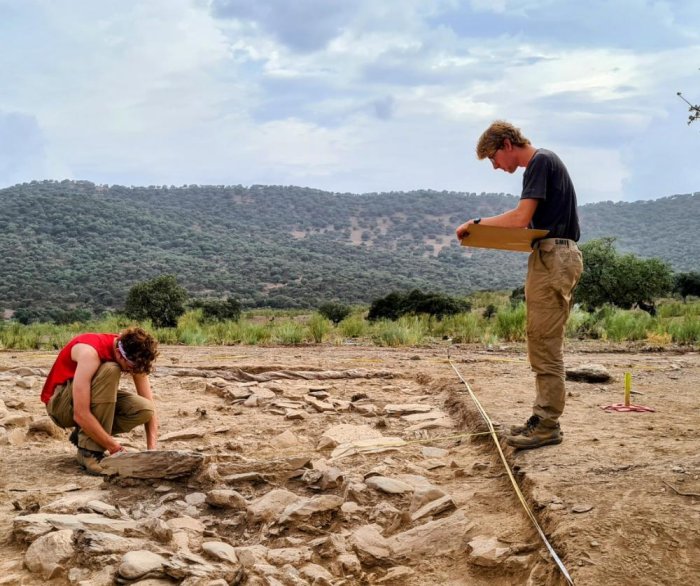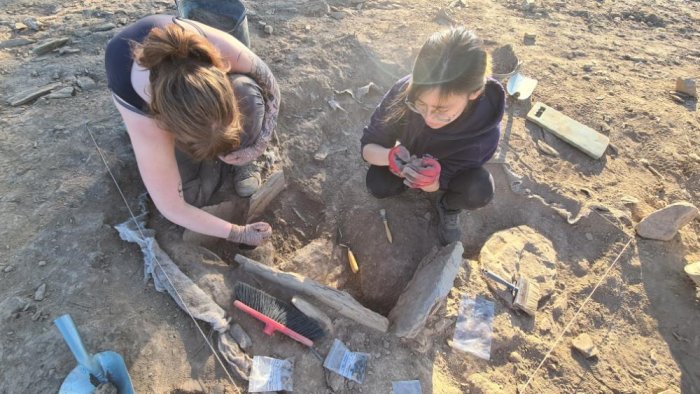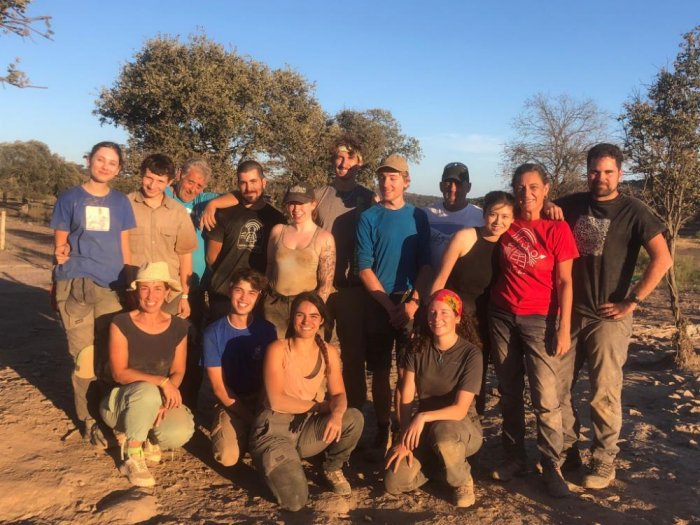Jan Bartek – AncientPages.com – A new decorated stela has been found in context, in the 3000-year-old funerary complex of Las Capellanías, in Cañaveral de León (Huelva, south-west of Spain). It is thought that late prehistoric stelae in Iberia were created to commemorate important personages.

Durham University Archaeology students have been part of an extraordinary archaeological discovery in Spain. Credit: Durham University
This new stela depicts a human figure with a headdress, a necklace, and two swords. The figure also has a detailed face, hands and feet, as well as male genitals. Las Capellanías is being excavated within a fieldwork project co-directed by the Department’s Dr Marta Diaz-Guardamino.
An amazing and very special find
There are three main reasons why this stela is such a valuable find.
Firstly, this is the third decorated stela found at this site, and the second one found in context. A report on the first stela is available now. The publication of the second stela is in preparation, but a preliminary short summary can be found on the Department website.
This find is remarkable, as the contexts of use of late prehistoric stelae in Iberia are largely unknown, despite over 120 years of research. This is due to a variety of reasons, including the conditions of discovery (normally agricultural work) and the lack of archaeological fieldwork conducted at the find spots.
Important funerary monuments
The find is also notable because it confirms, once more, what the second stela found at the site had suggested (in addition to some previously-known indirect evidence): that late prehistoric decorated stelae were primarily used as funerary monuments within mortuary sites (more details in this paper).
This also indicates that stelae-making could have been an activity invested with special meaning, carried out as part of funerary rituals in Late Bronze Age and Early Iron Age Iberia. The fact that three stelae have been found at Las Capellanías funerary complex indicates that previous finds of other grouped stelae – e.g. those stelae found in Hernán Pérez in northern Cáceres, central-west Spain, now part of the collections of the National Archaeology Museum in Madrid – could have corresponded also to stelae that were originally set in funerary complexes.

Students recording the area where the Cañaveral de León 3 stela was found. Credit: Durham University
Las Capellanías (like Hernán Pérez) is also located within one of the most important natural pathways linking two main river basins. During late prehistory, these pathways were key communication ‘highways’ between the middle Guadiana and the lower Guadalquivir basins. For Hernán Pérez, this ‘highway’ ran between the middle Tagus and the middle Duero, through the Gata mountain range.
Las Capellanías’ location here is significant, especially when we consider where funerary sites and settlements are on these ‘highways’. This shows how the role of decorated stelae as territorial markers relates to their role as funerary monuments.
Changing interpretations of gender
This find is also unique because of what it tells us about previous gender interpretations of the people represented on stelae. It shows that prior interpretations actually relate more to our modern binary conceptions of gender, than to those of prehistoric societies (read more in this paper).
This new stela from Cañaveral de León includes features like a necklace or a headdress. These are typically found on stelae classified as ‘headdress’ (or ‘diademated’) stelae, and usually interpreted as female. Traits typically found on the so-called ‘warrior’ stelae (such as swords) are normally interpreted as male. This gendering of standardised iconographies (possibly linked to specific social roles) was based on a very small percentage of cases displaying Sєxual bodily traits. Out of 31, four stelae were found with female Sєxual traits and headdress features. There were also four with male genitals and ‘warrior’ related paraphernalia, out of 147.
The stela 3 of Cañaveral de León changes all this.

Students digging a funerary cist at the Las Capellanías complex. Credit: Durham University
It combines traits of ‘headdress’ and ‘warrior’ types, showing that the social roles depicted by these standardized iconographies were more fluid than previously thought. Furthermore, as the new stela also includes male genitalia, it demonstrates that these social roles were not restricted to a specific gender, but could be ᴀssociated with different genders.

The Las Capellanías archaeological team. Credit: Durham University
The Las Capellanías archaeological team
This fieldwork project is being carried out within the Maritime Encounters project, funded by the Riksbankens Jubileumsfond (RJ). This project is led for Iberia by Dr Marta Díaz-Guardamino (Subproject 4), also with funding from the Department of Archaeology at Durham University, in co-direction with and supported by Timoteo Rivera and Prof. Leonardo García Sanjuán (University of Seville) and Prof. David Wheatley (University of Southampton).
See also: More Archaeology News
The excavation team was also composed of undergraduate and postgraduate students from Seville University, as well as undergraduate Durham University students.
The fieldwork season also benefited from the support of the Cañaveral de León city council, who helped the team organize various engagement activities with local citizens of all ages, as well as the support of various hardworking volunteers from Cañaveral de León – many thanks to all of them.
Written by Jan Bartek – AncientPages.com Staff Writer





